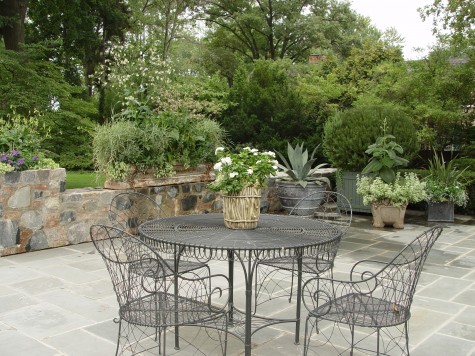 “Tuteur” is that elegant French word for those structures designed to support and make an orderly presentation of a vining plant. Vines are by nature unruly and out of control. Their exuberant habit of growth can be as exhausting to deal with as a recalcitrant two year old. Most plant climbers I find wanting for three things-good looks, thoughtful design, and proper size. Having made a succesful foray into steel wire structures via our spheres, it seemed time to design out the poor looks and clumsy design of what was available, and fabricate some good looking tuteurs I thought would work well.
“Tuteur” is that elegant French word for those structures designed to support and make an orderly presentation of a vining plant. Vines are by nature unruly and out of control. Their exuberant habit of growth can be as exhausting to deal with as a recalcitrant two year old. Most plant climbers I find wanting for three things-good looks, thoughtful design, and proper size. Having made a succesful foray into steel wire structures via our spheres, it seemed time to design out the poor looks and clumsy design of what was available, and fabricate some good looking tuteurs I thought would work well.
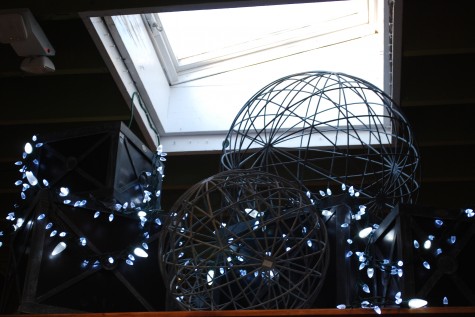 It was my intention from the beginning that a tuteur needed to be beautiful to look at once the garden had gone dormant. They might even be useful in another season. They might be designed with curves friendly to the natural shape of the vines. Those straight sided plant climbers with a curving vine bulging out of them-a bad marriage. And lastly, they need to be sized according to the eventual size of the vine they are meant to support-not to UPS shipping regulations. Some tuteurs have been designed to break down into several pieces-for economy of shipping; these never work.
It was my intention from the beginning that a tuteur needed to be beautiful to look at once the garden had gone dormant. They might even be useful in another season. They might be designed with curves friendly to the natural shape of the vines. Those straight sided plant climbers with a curving vine bulging out of them-a bad marriage. And lastly, they need to be sized according to the eventual size of the vine they are meant to support-not to UPS shipping regulations. Some tuteurs have been designed to break down into several pieces-for economy of shipping; these never work.

The sculpture of a well designed tuteur elevates a useful object to a level deserving of the word ornament-provided it is is pleasing to look at on its own. Our first round of tuteurs were finished in a clear powdercoat; this finish did not have a long life. In constant contact with leaves, water and weather, it wasn’t long before the rust took over. Though there are gardens for whom rusty steel is perfect, I was after a more serious and distinguished look.
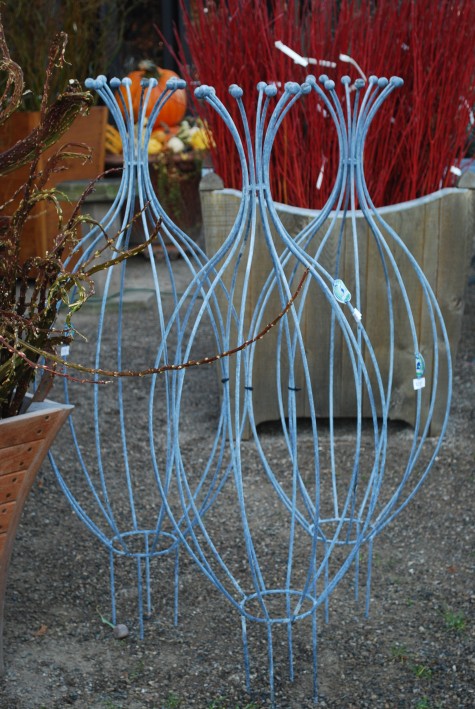 All of our tuteurs make reference to natural forms. Some say these look like onions or shallots; others are reminded of garlic cloves. In any event, we make these forms in three sizes; the size dictates the shape. Not all shapes work scaled up, or scaled down-this I learned from Rob. Sometimes the proportions have to be changed when the size changes. The ball finials at the top make the structure look finished and dressy. They also protect the gardener from a poke in the eye-has not every gardener be stabbed by their plant climbers, stakes and supports at one time or another?
All of our tuteurs make reference to natural forms. Some say these look like onions or shallots; others are reminded of garlic cloves. In any event, we make these forms in three sizes; the size dictates the shape. Not all shapes work scaled up, or scaled down-this I learned from Rob. Sometimes the proportions have to be changed when the size changes. The ball finials at the top make the structure look finished and dressy. They also protect the gardener from a poke in the eye-has not every gardener be stabbed by their plant climbers, stakes and supports at one time or another?
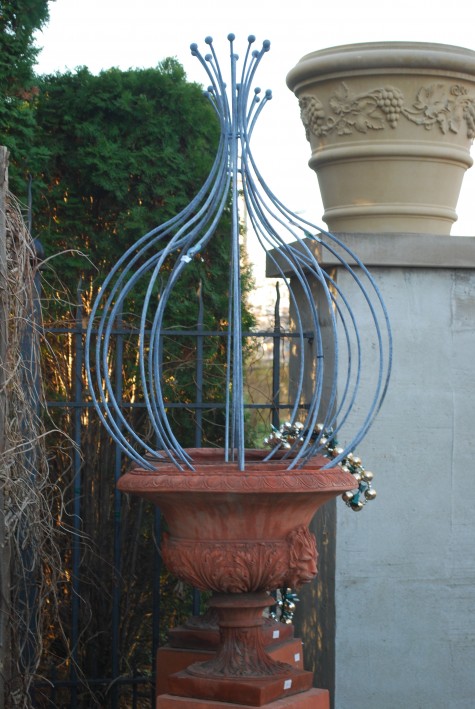 This pair of English concrete pots are all the better for their top dressing. The pots could be planted with ivy growing over one side of the tuteur in the summer-or not. They could be left out all winter empty, and look great. It is a test of a good garden pot presentation-does it represent as well empty, as it does overflowing with flowers?
This pair of English concrete pots are all the better for their top dressing. The pots could be planted with ivy growing over one side of the tuteur in the summer-or not. They could be left out all winter empty, and look great. It is a test of a good garden pot presentation-does it represent as well empty, as it does overflowing with flowers?
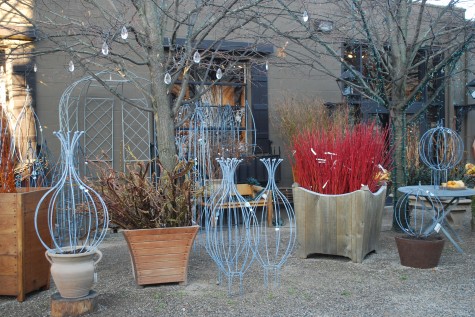 I did not anticipate how very much a part of the winter season these sculptures would prove to be. They look great with greens, berries and other materials from the garden at their base. They make something showy of our off season.
I did not anticipate how very much a part of the winter season these sculptures would prove to be. They look great with greens, berries and other materials from the garden at their base. They make something showy of our off season.

I don’t know how many times I have tried to support my plants when they grew large enough to hide my supports. This is a classic case of way too little, too late. A grown plant takes poorly to being corseted-they always have that look about them, no matter how skillfully you try to achieve a natural look. If a tuteur looks good even when it isn’t working, I have good reason to get them out well in advance.
 The shapes work in both contemporary and traditional gardens-what a relief to be able to offer a client with contemporary taste, a tuteur that looks like it belongs to them.
The shapes work in both contemporary and traditional gardens-what a relief to be able to offer a client with contemporary taste, a tuteur that looks like it belongs to them.
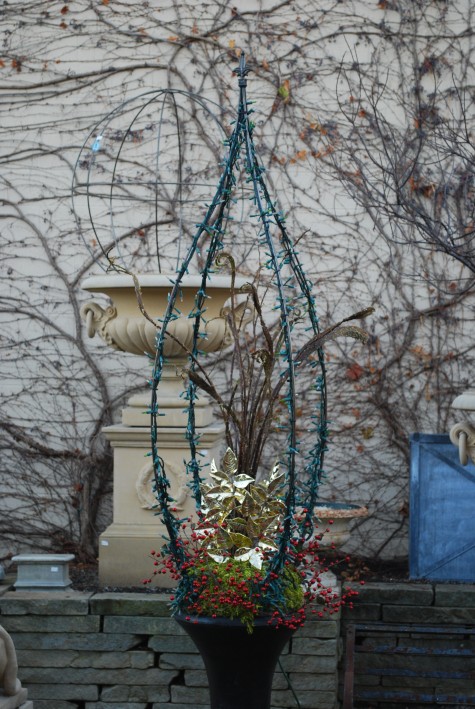 Decorating for the holidays outdoors is a form of gardening, and those strings of lights common to the season are a type of vine. Some tuteurs we design fulfills this purpose. They are very simple in shape, and overscaled such that the lit forms read as topiary at night. It will not be long before it starts getting dark at 4 in the afternoon here-any gesture defiant of the dark, I like.
Decorating for the holidays outdoors is a form of gardening, and those strings of lights common to the season are a type of vine. Some tuteurs we design fulfills this purpose. They are very simple in shape, and overscaled such that the lit forms read as topiary at night. It will not be long before it starts getting dark at 4 in the afternoon here-any gesture defiant of the dark, I like.
 This is my favorite climber, designed after Rob’s hand wrapped galvanized wire tomato cages. The tuteur is much larger at the top than the bottom. My sweet autumn clematis may have 6 stout stems coming out of the ground, but once it gets to 14 feet tall, it is billowing out in every direction; this tuteur handles that. The fern curl detail at the top is a simple reference to the look of an ostrich fern breaking dormancy in the spring; this is a form I never tire of. We make these in a range of sizes. Our individual plant stakes of this design come straight out of the ground or pot, and then gracefully curve out to catch whatever happens to be growing that way. We make them as half rounds that can be snugged up against a wall. In short, we are gardeners, designing for gardeners. In this application, they provide wire perches for a collection of holiday birds.
This is my favorite climber, designed after Rob’s hand wrapped galvanized wire tomato cages. The tuteur is much larger at the top than the bottom. My sweet autumn clematis may have 6 stout stems coming out of the ground, but once it gets to 14 feet tall, it is billowing out in every direction; this tuteur handles that. The fern curl detail at the top is a simple reference to the look of an ostrich fern breaking dormancy in the spring; this is a form I never tire of. We make these in a range of sizes. Our individual plant stakes of this design come straight out of the ground or pot, and then gracefully curve out to catch whatever happens to be growing that way. We make them as half rounds that can be snugged up against a wall. In short, we are gardeners, designing for gardeners. In this application, they provide wire perches for a collection of holiday birds.
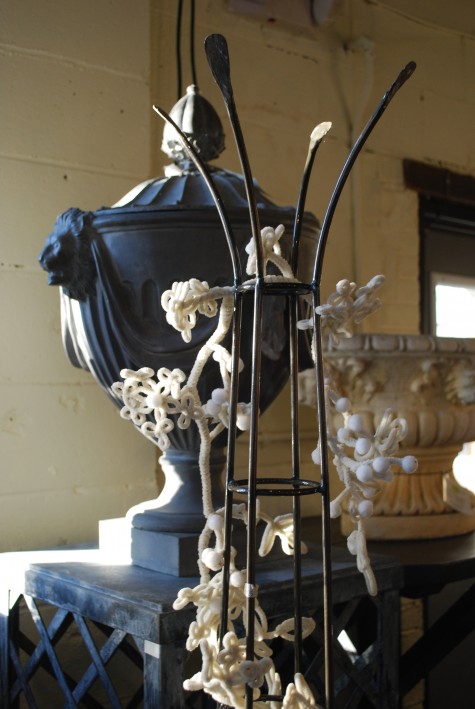
Simply functional, and simply beautiful, this is what I am after.
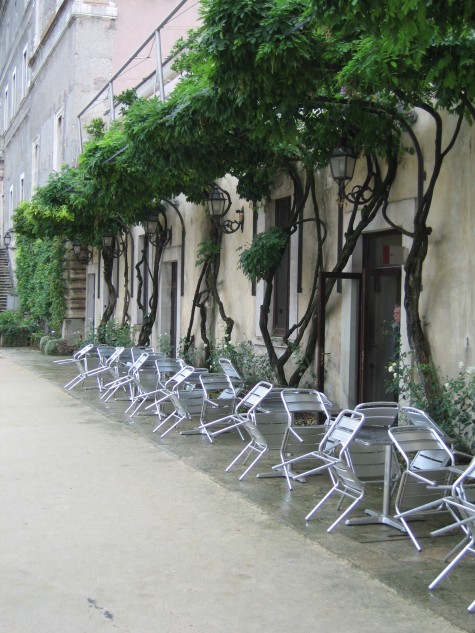 Vining plants have a very special charm. Provided they have secure support, they take up little to no room in a garden. Most of them are energetic growers; this I especially appreciate in a plant. Wisteria gives new meaning to the phrase “willing and able”, but with proper support and ruthless pruning, their sculptural effect in a garden will rival their long and languid racemes of flowers in June. I would only advise that any thought of planting wisteria should be undertaken in tandem with where the iron will come from. Iron support, and iron fisted supervision are must haves. Any other scenario risks waking up to it growing in your bedroom window.
Vining plants have a very special charm. Provided they have secure support, they take up little to no room in a garden. Most of them are energetic growers; this I especially appreciate in a plant. Wisteria gives new meaning to the phrase “willing and able”, but with proper support and ruthless pruning, their sculptural effect in a garden will rival their long and languid racemes of flowers in June. I would only advise that any thought of planting wisteria should be undertaken in tandem with where the iron will come from. Iron support, and iron fisted supervision are must haves. Any other scenario risks waking up to it growing in your bedroom window.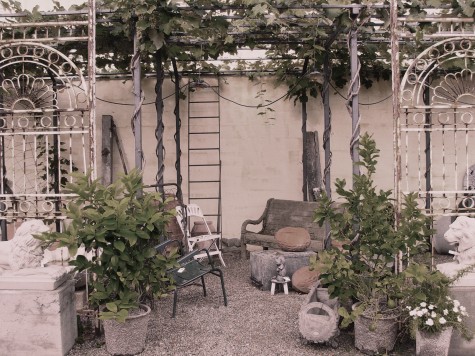
 Grapes are like any other vine-lax in habit, and best grown within the confines of a well run dictatorship. They are sterling performers with a good gardener at the helm. But like the willows and dogwoods I discussed yesterday, their strong suit is about the harvest. I will never grow grapes for the table or for wine; I suspect the art and science behind that is considerably more than I imagine or could grasp. But I do value the look and feel of ornament made from materials from the garden.
Grapes are like any other vine-lax in habit, and best grown within the confines of a well run dictatorship. They are sterling performers with a good gardener at the helm. But like the willows and dogwoods I discussed yesterday, their strong suit is about the harvest. I will never grow grapes for the table or for wine; I suspect the art and science behind that is considerably more than I imagine or could grasp. But I do value the look and feel of ornament made from materials from the garden.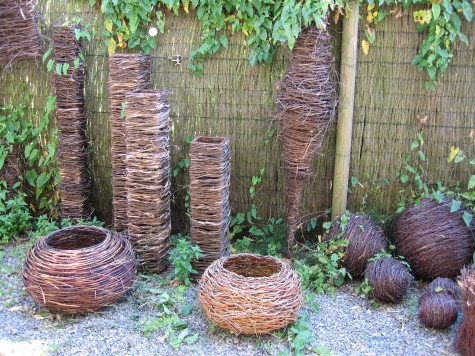 My shop has featured many garden ornaments made from vines and flexible twigs over the years. They never seem to loose their appeal. Those woven over a steel framework have an astonishing long life; they are as beautiful breaking down as they are brand new. Every year I pick up a large French basket from a client planted with a colony of medium sized agaves, amazed that it is still all of a piece. Enamoured as I am of Belgian design both inside and out, these airy, often hairy objects are a beautiful foil to brick, plaster, stone, concrete and iron.
My shop has featured many garden ornaments made from vines and flexible twigs over the years. They never seem to loose their appeal. Those woven over a steel framework have an astonishing long life; they are as beautiful breaking down as they are brand new. Every year I pick up a large French basket from a client planted with a colony of medium sized agaves, amazed that it is still all of a piece. Enamoured as I am of Belgian design both inside and out, these airy, often hairy objects are a beautiful foil to brick, plaster, stone, concrete and iron.  Only in England would you find a business named The English Hurdle and Basket Center. Despite sounding like remedial center for floundering collegians, it actually produces vessels and baskets of great artistry. The graceful shapes belie the skill and strength needed to form them. The artist Serena de la Hey, for whom I have the greatest respect, creates truly inspired sculpture for the garden. My very first purchase for my shop in 1995 was a order for one of her boar sculptures. She is well worth a look;
Only in England would you find a business named The English Hurdle and Basket Center. Despite sounding like remedial center for floundering collegians, it actually produces vessels and baskets of great artistry. The graceful shapes belie the skill and strength needed to form them. The artist Serena de la Hey, for whom I have the greatest respect, creates truly inspired sculpture for the garden. My very first purchase for my shop in 1995 was a order for one of her boar sculptures. She is well worth a look; 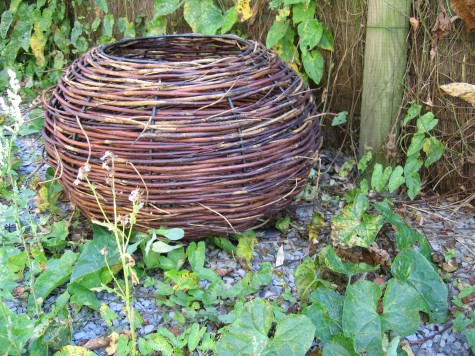 The framework that is visible here makes the object eminently renewable. Though the wood and bark of willow is remarkably resilient to weather, it will eventually deteriorate. I appreciate the chance to renew, redo, and rethink an object; this is a good part of the appeal of twig and branch sculpture.
The framework that is visible here makes the object eminently renewable. Though the wood and bark of willow is remarkably resilient to weather, it will eventually deteriorate. I appreciate the chance to renew, redo, and rethink an object; this is a good part of the appeal of twig and branch sculpture.  Though this stag looks perfectly at home in my client’s landscape, it is made in California. The metal frame will last a lifetime. The willow is painstakingly woven; the sculpture is heavy and sturdy. Carleen’s life size animal sculptures are enchanting. I have seen enough of them to recognize which of her artisans is responsible for a specific piece. This is grape vine, beautifully rendered.
Though this stag looks perfectly at home in my client’s landscape, it is made in California. The metal frame will last a lifetime. The willow is painstakingly woven; the sculpture is heavy and sturdy. Carleen’s life size animal sculptures are enchanting. I have seen enough of them to recognize which of her artisans is responsible for a specific piece. This is grape vine, beautifully rendered.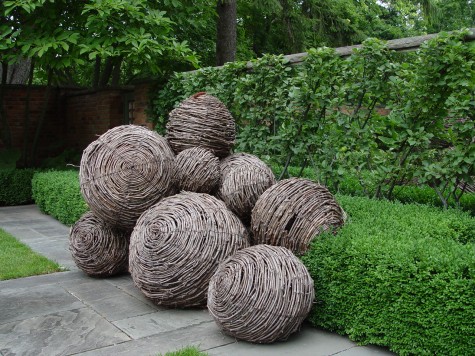
 Some months ago I wrote an essay about designing a landscape for a sculpture, but perhaps equally as sculptural were the tree trunks that played such a critical role in the realization of that design. I do not think I ever physically understood what a tree was all about until I was face to face with these stumps. Farmers need to clear land to plant their crops; this means digging out the stumps. The microorganisms that decompose wood work at a snail’s pace. In farm areas in Michigan it is common to see fences made from these stumps. For this project, I persuaded a farmer to part with 150 feet of his fence. The experience would provide me with a graphic understanding of what goes on inside the bark of a tree.
Some months ago I wrote an essay about designing a landscape for a sculpture, but perhaps equally as sculptural were the tree trunks that played such a critical role in the realization of that design. I do not think I ever physically understood what a tree was all about until I was face to face with these stumps. Farmers need to clear land to plant their crops; this means digging out the stumps. The microorganisms that decompose wood work at a snail’s pace. In farm areas in Michigan it is common to see fences made from these stumps. For this project, I persuaded a farmer to part with 150 feet of his fence. The experience would provide me with a graphic understanding of what goes on inside the bark of a tree. 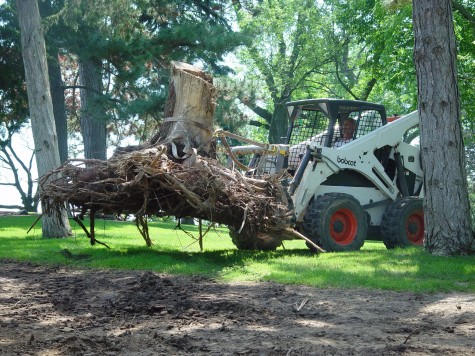 What arrived by flatbed was vastly more than I had bargained for. They stood eight feet tall and were much better than that in width. Though the fence had been in place for 10 years, handling the size and weight of them was a strain both for my crew, and my bobcat skid steer. The thick wiry roots were as unyielding as steel. It is so easy to stop truly seeing those things one sees every day. A lifetime of seeing these giant living things rising out of the ground to incredible heights had apparently dulled my sense of them.
What arrived by flatbed was vastly more than I had bargained for. They stood eight feet tall and were much better than that in width. Though the fence had been in place for 10 years, handling the size and weight of them was a strain both for my crew, and my bobcat skid steer. The thick wiry roots were as unyielding as steel. It is so easy to stop truly seeing those things one sees every day. A lifetime of seeing these giant living things rising out of the ground to incredible heights had apparently dulled my sense of them. 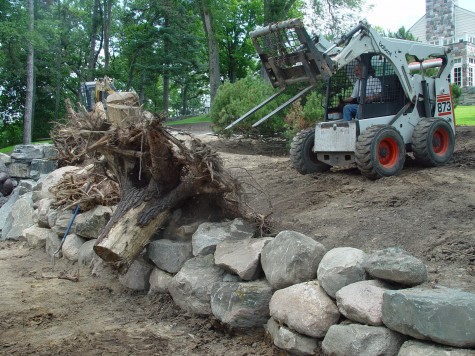 I was so struck by how the heart of a tree lives on long after its green life has gone down. The heartwood is transformed by an internal chemical process into a material of great strength. The wood of a tree enables nutrients to travel from the roots to the leaves, its core function is to keep the plant upright. This exposure to wood is much different than looking at planks, or plywood, porch furniture, or fuel for my fireplace. Processed wood is obviously a material that few could do without, but these raw forms are incredibly beautiful.
I was so struck by how the heart of a tree lives on long after its green life has gone down. The heartwood is transformed by an internal chemical process into a material of great strength. The wood of a tree enables nutrients to travel from the roots to the leaves, its core function is to keep the plant upright. This exposure to wood is much different than looking at planks, or plywood, porch furniture, or fuel for my fireplace. Processed wood is obviously a material that few could do without, but these raw forms are incredibly beautiful.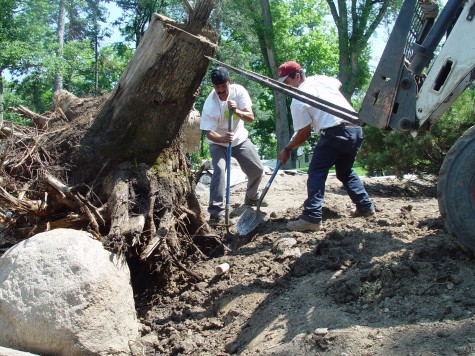 Setting them in place took days. Placing them close to the final location was done by machine. This was just the beginning; as I wanted them to look as though they might had always been there, we dug them in. The forks on the skid steer held the stumps in place, as it would have taken an army to do that by hand. Though this group of trees was no longer living, the story of how the network of feeder and support roots broadly rise out of the ground and grow to support these very large plants is there to read.
Setting them in place took days. Placing them close to the final location was done by machine. This was just the beginning; as I wanted them to look as though they might had always been there, we dug them in. The forks on the skid steer held the stumps in place, as it would have taken an army to do that by hand. Though this group of trees was no longer living, the story of how the network of feeder and support roots broadly rise out of the ground and grow to support these very large plants is there to read. 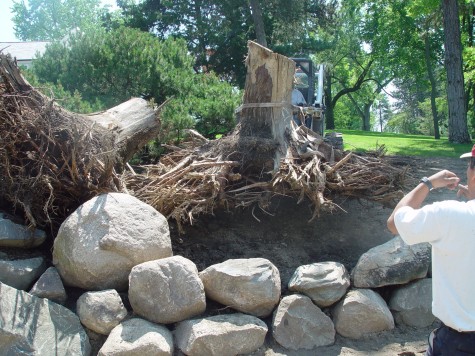
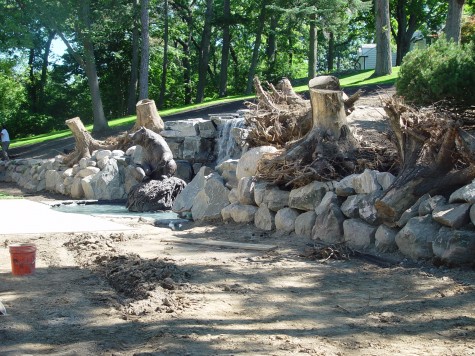 It is a very good idea to consider what will need to go on below ground, and what will eventually be-before planting a large growing tree. I have had occasion to tell clients that their silver maples were an excellent example of God’s biggest weeds. Urban lots and tree lawns are poor locations for giant trees. They suffer from restricted space and rootzones. Given that it takes a long time to grow a tree, imagining the eventual size at the beginning only makes good sense.
It is a very good idea to consider what will need to go on below ground, and what will eventually be-before planting a large growing tree. I have had occasion to tell clients that their silver maples were an excellent example of God’s biggest weeds. Urban lots and tree lawns are poor locations for giant trees. They suffer from restricted space and rootzones. Given that it takes a long time to grow a tree, imagining the eventual size at the beginning only makes good sense.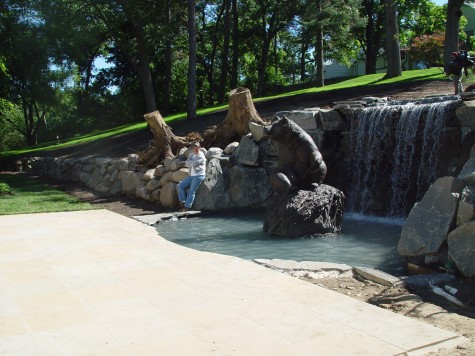 This nine foot tall bronze bear seated on his beaver’s nest is getting some company of a similar scale. The rain to come will wash the stumps. The digging in will deposit soil in pockets, enabling plants to grow. A collection of dwarf conifers would cover the ground.
This nine foot tall bronze bear seated on his beaver’s nest is getting some company of a similar scale. The rain to come will wash the stumps. The digging in will deposit soil in pockets, enabling plants to grow. A collection of dwarf conifers would cover the ground.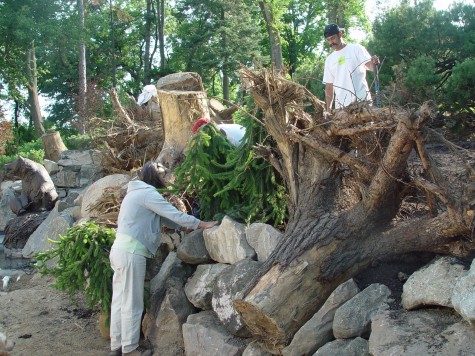
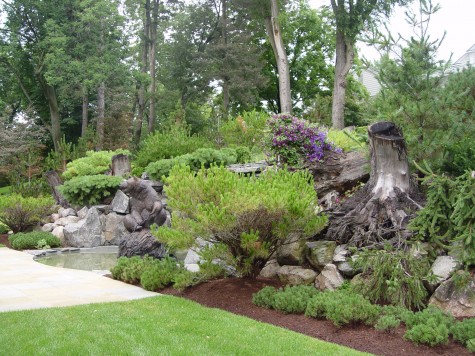
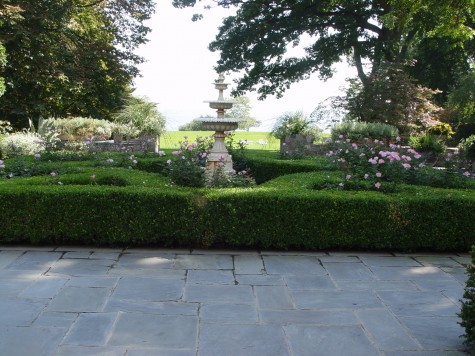 I have clients whose interest in gardens runs to green, and more green. Though my love for the green of the plant is every bit as great as my love for their flowers, I have never had the discipline it takes to restrict my own palette like this. But I find that whenever a client represents their own point of view outdoors, the result looks just right.
I have clients whose interest in gardens runs to green, and more green. Though my love for the green of the plant is every bit as great as my love for their flowers, I have never had the discipline it takes to restrict my own palette like this. But I find that whenever a client represents their own point of view outdoors, the result looks just right.  These large stone and brick piers punctuate a pair of walls that partially enclose a terrace. I plant them with a mix of plants whose textures are as unlike stone and brick as possible. This is a matter of directing visual attention. The window boxes on the roof of my shop are not so gorgeous. They are made of galvanized sheet metal ordinarily used in the production of ductwork for the heating and cooling industry. The sole function of those boxes is to hold the soil, nutrients and water for the plants-they have no visual interest in and of themselves. The intent here is to acknowledge the beautiful surface of the container as much as the planting.
These large stone and brick piers punctuate a pair of walls that partially enclose a terrace. I plant them with a mix of plants whose textures are as unlike stone and brick as possible. This is a matter of directing visual attention. The window boxes on the roof of my shop are not so gorgeous. They are made of galvanized sheet metal ordinarily used in the production of ductwork for the heating and cooling industry. The sole function of those boxes is to hold the soil, nutrients and water for the plants-they have no visual interest in and of themselves. The intent here is to acknowledge the beautiful surface of the container as much as the planting.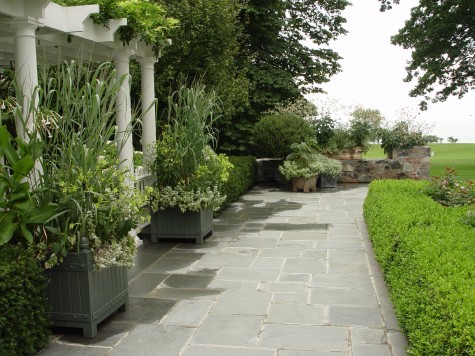 A green planting has a quiet and serene look, as the greens so closely relate in color and value. The green of these painted Belgian oak boxes harmonizes with the color of the bluestone terrace; the relationship is a subtle one. The Dallas Blues panic grass repeats that color. Monochromatic color schemes tend to read that way, although an ocean of orange is anything but serene. Add some contrasting purple to that orange, which in turn contrasts with the green, and you have a visual party going on. These greens speak softly.
A green planting has a quiet and serene look, as the greens so closely relate in color and value. The green of these painted Belgian oak boxes harmonizes with the color of the bluestone terrace; the relationship is a subtle one. The Dallas Blues panic grass repeats that color. Monochromatic color schemes tend to read that way, although an ocean of orange is anything but serene. Add some contrasting purple to that orange, which in turn contrasts with the green, and you have a visual party going on. These greens speak softly.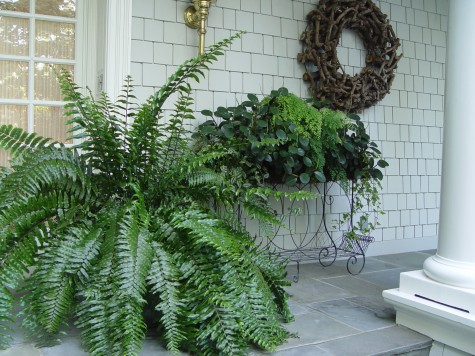 A porch planting plays the spiky texture of a tropical fern off the round chubby leaves of a of large scale pepperomia; the effect is pleasing, not demanding. The elegant English wirework planter reminiscent of vintage conservatory furniture is balanced with a simple and very rustic wreath that hangs on the wall year round.
A porch planting plays the spiky texture of a tropical fern off the round chubby leaves of a of large scale pepperomia; the effect is pleasing, not demanding. The elegant English wirework planter reminiscent of vintage conservatory furniture is balanced with a simple and very rustic wreath that hangs on the wall year round. The container collection is a beautiful one. An American stoneware grape panel container from the 1920’s, and English lead and the Belgian oak box are very different in materials and forms, but very much alike in feeling.
The container collection is a beautiful one. An American stoneware grape panel container from the 1920’s, and English lead and the Belgian oak box are very different in materials and forms, but very much alike in feeling.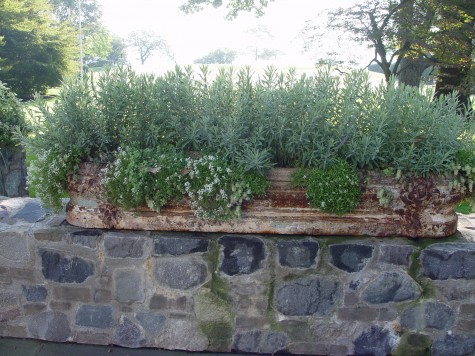 A pair of very old and distinctive French iron planters sit on the walls. I usually plant them with lavender, and alyssum, showy oregano, and whatever other herb like plant seems appropriate. The effect is graceful; the muted colors of every aspect of this space invite contemplation.
A pair of very old and distinctive French iron planters sit on the walls. I usually plant them with lavender, and alyssum, showy oregano, and whatever other herb like plant seems appropriate. The effect is graceful; the muted colors of every aspect of this space invite contemplation.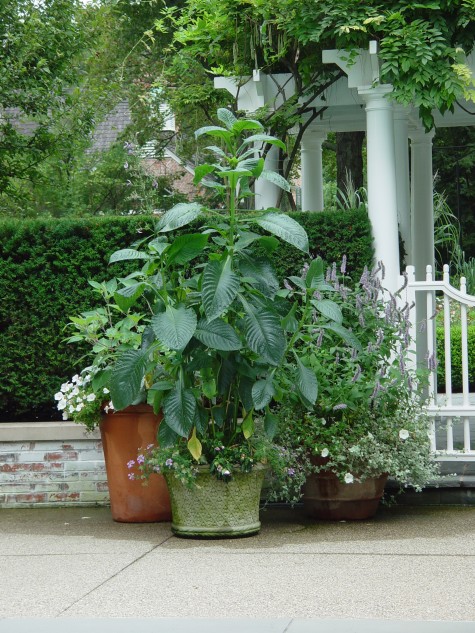 Some plants stay green all season, as our summer is too short to permit flowering-as in this large tropical salvia. The fine perennial hyssop hangs on to the ghostly lavender of its flowers a very long time; this is repeated in a lavender trailing verbena. Though there is some color here, it is the relationships of the greens that reads first and foremost.
Some plants stay green all season, as our summer is too short to permit flowering-as in this large tropical salvia. The fine perennial hyssop hangs on to the ghostly lavender of its flowers a very long time; this is repeated in a lavender trailing verbena. Though there is some color here, it is the relationships of the greens that reads first and foremost. I think the leaves of tibouchina grandiflora are surely my favorite. The large oval leaves are completely covered in fine white hairs; they are a marvel. Their contrast to the needles of the rosemary topiary is considerable in form, and little in color. Variegated licorice is one of the most versatile of all green plants. The leaves sport two different shades of green; the blotches are very blue green, while the edges are more yellow-green. It works with every plant with which it is paired. This collection of pots benefits from the lively effect of its habit of growth, and relative lightness. Subtle does not mean sleepy.
I think the leaves of tibouchina grandiflora are surely my favorite. The large oval leaves are completely covered in fine white hairs; they are a marvel. Their contrast to the needles of the rosemary topiary is considerable in form, and little in color. Variegated licorice is one of the most versatile of all green plants. The leaves sport two different shades of green; the blotches are very blue green, while the edges are more yellow-green. It works with every plant with which it is paired. This collection of pots benefits from the lively effect of its habit of growth, and relative lightness. Subtle does not mean sleepy.